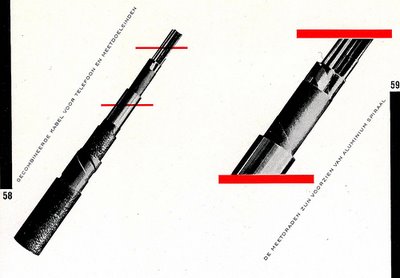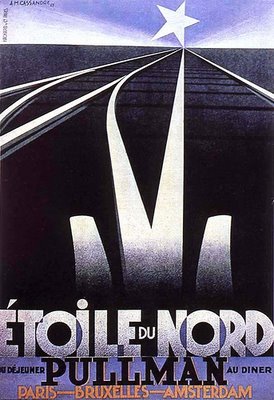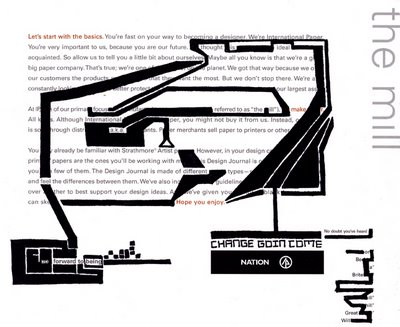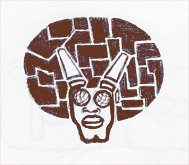
Wednesday, September 27, 2006
Tuesday, September 26, 2006
Sunday, September 24, 2006
Tuesday, September 19, 2006
Interesting Article about the role of a Graphic Designer.
Does graphic design really make a difference?
(18) Comments By Dyske Suematsu
It’s nice to think our work can change the world, but is that really the case?
In my view, there is a fundamental misunderstanding in our society about what graphic design is. Here is an interesting observation by Ludwig Wittgenstein to illustrate this point: “Often, when I have had a picture well framed or have hung it in the right surroundings, I have caught myself feeling as proud as if I had painted it myself.” This is the most common pitfall of graphic designers. Since our work is often viewed by thousands or even millions of people, we become proud of our work as if the message was our own.
Fooling ourselves to believe that we are greater than what we actually are, cheapens the value of graphic design. We would have a better chance of making a real contribution to the world if we did not have a delusion of grandeur about it. The real value of graphic design cannot be realized if we misunderstand what it is.
Here is a personal story to illustrate this point: Years ago, I was at a small take-out restaurant in the Flatiron district of Manhattan. Though there was no fancy logo, sign, or window display, the place was quite busy. I ordered fish and chips, and when it was done, the man behind the counter, whose face was covered with grease and sweat, offered me a special sauce. The way he so proudly presented his sauce deeply touched my heart and I’ve never forgotten it since. As I thanked him for the sauce, I thought to myself, “I wouldn’t last a day behind this counter.” I could not imagine how this man was able to work there every day, and still find joy in offering his sauce. He seemed to possess an infinite capacity to be happy. In comparison, I felt like a spoiled brat. This man clearly had no expectation of changing the world. He had no delusion of grandeur about his job. Yet, he was able to touch my heart with his love for food and people, and became a source of inspiration for me.
In comparing our profession to others, it might be tempting, for instance, to compare graphic designers to architects, but the latter have a higher degree of fusion between form and content. There are of course many exceptions, but most great architects are responsible for the content of their own work. For example, the socio-political philosophies of Peter Eisenman and Rem Koolhaas are a significant part of what they sell and what their clients expect from them. In contrast, most graphic designers work hand-in-hand with others who create the content, such as advertisers, writers (books), musicians (album covers), and business owners (branding). If you are a graphic designer working for Greenpeace, the message behind your work is not yours. You may have a philosophy about how a certain type of message can be delivered more effectively, but that is independent of the message itself. The message does not originate in the designer. Architects on the other hand, deal with both types of philosophy.
A better comparison would be architectural engineers to graphic designers. However, most graphic designers would find this insulting. We want to believe that we are not just craftsmen or technicians, and that we have important things of our own to say. The field of graphic design attracts people with big egos because it is a business with high exposure. In fact, it is a business of high exposure, period. Because of that, it also attracts people who like to believe that they can change the world. Or, perhaps the process is the other way around. People who are interested in changing the world are naturally interested in communication, and so if they keep at it, they eventually become very good at it, which in turn leads them to apply their skills professionally.
Don’t get me wrong; I like graphic design, and I enjoy my work, but I don’t want to be confused about what it is. As a baker, you cannot expect to change the world, but that does not mean that baker is an irrelevant occupation. Bakers do make a difference in the world, but that cannot be the expectation of a baker. In fact, having no such expectation would work better towards making a real difference.
Graphic design is a noble occupation with a real purpose, but for that purpose to be realized, we need to see graphic design for what it actually is, and have certain humility about it. Graphic design is a supporting role, not a leading role. Musicians understand and appreciate better the value of being in supporting roles. If every player in a band tried to be a star, it would create a musical disaster. Not everyone is destined to be a star, and for someone to be a star, there must be others who are willing to play the supporting roles.
Graphic design is misleading in that it looks like a leading role, when in fact it is a supporting role. If one wants to play a leading role, one should learn to play violin instead of playing viola very loudly in order to be noticed. Otherwise, one will end up giving the viola a bad name.
(18) Comments By Dyske Suematsu
It’s nice to think our work can change the world, but is that really the case?
In my view, there is a fundamental misunderstanding in our society about what graphic design is. Here is an interesting observation by Ludwig Wittgenstein to illustrate this point: “Often, when I have had a picture well framed or have hung it in the right surroundings, I have caught myself feeling as proud as if I had painted it myself.” This is the most common pitfall of graphic designers. Since our work is often viewed by thousands or even millions of people, we become proud of our work as if the message was our own.
Fooling ourselves to believe that we are greater than what we actually are, cheapens the value of graphic design. We would have a better chance of making a real contribution to the world if we did not have a delusion of grandeur about it. The real value of graphic design cannot be realized if we misunderstand what it is.
Here is a personal story to illustrate this point: Years ago, I was at a small take-out restaurant in the Flatiron district of Manhattan. Though there was no fancy logo, sign, or window display, the place was quite busy. I ordered fish and chips, and when it was done, the man behind the counter, whose face was covered with grease and sweat, offered me a special sauce. The way he so proudly presented his sauce deeply touched my heart and I’ve never forgotten it since. As I thanked him for the sauce, I thought to myself, “I wouldn’t last a day behind this counter.” I could not imagine how this man was able to work there every day, and still find joy in offering his sauce. He seemed to possess an infinite capacity to be happy. In comparison, I felt like a spoiled brat. This man clearly had no expectation of changing the world. He had no delusion of grandeur about his job. Yet, he was able to touch my heart with his love for food and people, and became a source of inspiration for me.
In comparing our profession to others, it might be tempting, for instance, to compare graphic designers to architects, but the latter have a higher degree of fusion between form and content. There are of course many exceptions, but most great architects are responsible for the content of their own work. For example, the socio-political philosophies of Peter Eisenman and Rem Koolhaas are a significant part of what they sell and what their clients expect from them. In contrast, most graphic designers work hand-in-hand with others who create the content, such as advertisers, writers (books), musicians (album covers), and business owners (branding). If you are a graphic designer working for Greenpeace, the message behind your work is not yours. You may have a philosophy about how a certain type of message can be delivered more effectively, but that is independent of the message itself. The message does not originate in the designer. Architects on the other hand, deal with both types of philosophy.
A better comparison would be architectural engineers to graphic designers. However, most graphic designers would find this insulting. We want to believe that we are not just craftsmen or technicians, and that we have important things of our own to say. The field of graphic design attracts people with big egos because it is a business with high exposure. In fact, it is a business of high exposure, period. Because of that, it also attracts people who like to believe that they can change the world. Or, perhaps the process is the other way around. People who are interested in changing the world are naturally interested in communication, and so if they keep at it, they eventually become very good at it, which in turn leads them to apply their skills professionally.
Don’t get me wrong; I like graphic design, and I enjoy my work, but I don’t want to be confused about what it is. As a baker, you cannot expect to change the world, but that does not mean that baker is an irrelevant occupation. Bakers do make a difference in the world, but that cannot be the expectation of a baker. In fact, having no such expectation would work better towards making a real difference.
Graphic design is a noble occupation with a real purpose, but for that purpose to be realized, we need to see graphic design for what it actually is, and have certain humility about it. Graphic design is a supporting role, not a leading role. Musicians understand and appreciate better the value of being in supporting roles. If every player in a band tried to be a star, it would create a musical disaster. Not everyone is destined to be a star, and for someone to be a star, there must be others who are willing to play the supporting roles.
Graphic design is misleading in that it looks like a leading role, when in fact it is a supporting role. If one wants to play a leading role, one should learn to play violin instead of playing viola very loudly in order to be noticed. Otherwise, one will end up giving the viola a bad name.
Monday, September 11, 2006
What is good graphic design?
What makes a good graphic designer, and how can you be sure of getting good graphic design? The graphic design market can be confusing. At first sight, inexpensive graphic design looks readily obtainable, because there are a lot of good people out there eager to get some references. But for the customer, getting the right graphic design is not easy. In fact it's a problem. Because what is the right graphic design?
Just because someone can work with Photoshop or has a graphic design qualification does not necessarily mean they are a good designer. An able designer needs far more qualities than just a good eye for colour, form and detail. Design is an entity.
Good graphic design tells a visual story. Good graphic design employs succinct psychological tools, such as reactions to and associations with forms and colours. But above all, good graphic design is a visual expression that functions in optimised interaction with communication and strategy. This makes heavy demands on the designer's ability to integrate design into the whole. It also calls for considerable insight into the customer's firm, the purpose of the message and the underlying strategic thinking. Because like communication, design must reflect the customer's profile, appeal to the customer's buyers/partners, and also distance the customer from his competitors.
A good designer must therefore be able to be creative within the framework laid down by the customer. Bubbling creativity is of no use without a sense of context and economic realism. A designer must be capable of focused working within financial and time limitations. This is the challenge, and it is one of the areas a good designer gets paid to master.
That the designer must work within the framework of the customer's situation and market can surprise no one. But this does not mean it is the customer who sets the limits. The customer possesses an in-depth insight into the circumstances of his business. But precisely because he is so deeply involved it is important that fresh eyes should be brought to bear.
Innovation is a word commonly used in the value sets of many companies. But being innovative means being willing to move boundaries – not least within oneself. There is a difference between being creative and being innovative. Being creative means getting the best out of the given framework. This can be done by any good designer. Being innovative means thinking beyond the given boundaries to take a fresh look and set new boundaries. This takes courage and trust – on the part of both customer and designer. The best graphic design is therefore produced by a designer who knows the key questions to ask the customer and who transcends the conventional, and by a customer who has confidence in the end-result, dares to break limits – and to invest in the future.
Creativity, inspiration and above all motivation must never be forgotten. Because being a good graphic designer means being thoroughly tuned in, finding inspiration in the oddest things, and preferably also having access to exactly the right sources. An awareness of current and future trends is thus an integral part of a graphic designer's toolbox. This awareness provides the source of the inspiration that the designer passes on to the customer, but is also enables the designer himself to achieve self-renewal and find fresh creativity.
It should be clearly understood that a professional graphic designer does not necessarily have his own style. This is because the designer's job is to supply a message that has to fit the company's view of itself, the company's strategy, and the company's desired market position. Another reason is that the design must appeal to the values of the users. Good design must be design that works: design that helps generate revenue and optimise the understanding of the message. Such design can only result from thorough preparation, an analytical appreciation of the company's message and market, and naturally a creative mind.
By Jan Nielsen, Creative Manager, and Mette Falk, Graphic Designer, Kühl+co
Just because someone can work with Photoshop or has a graphic design qualification does not necessarily mean they are a good designer. An able designer needs far more qualities than just a good eye for colour, form and detail. Design is an entity.
Good graphic design tells a visual story. Good graphic design employs succinct psychological tools, such as reactions to and associations with forms and colours. But above all, good graphic design is a visual expression that functions in optimised interaction with communication and strategy. This makes heavy demands on the designer's ability to integrate design into the whole. It also calls for considerable insight into the customer's firm, the purpose of the message and the underlying strategic thinking. Because like communication, design must reflect the customer's profile, appeal to the customer's buyers/partners, and also distance the customer from his competitors.
A good designer must therefore be able to be creative within the framework laid down by the customer. Bubbling creativity is of no use without a sense of context and economic realism. A designer must be capable of focused working within financial and time limitations. This is the challenge, and it is one of the areas a good designer gets paid to master.
That the designer must work within the framework of the customer's situation and market can surprise no one. But this does not mean it is the customer who sets the limits. The customer possesses an in-depth insight into the circumstances of his business. But precisely because he is so deeply involved it is important that fresh eyes should be brought to bear.
Innovation is a word commonly used in the value sets of many companies. But being innovative means being willing to move boundaries – not least within oneself. There is a difference between being creative and being innovative. Being creative means getting the best out of the given framework. This can be done by any good designer. Being innovative means thinking beyond the given boundaries to take a fresh look and set new boundaries. This takes courage and trust – on the part of both customer and designer. The best graphic design is therefore produced by a designer who knows the key questions to ask the customer and who transcends the conventional, and by a customer who has confidence in the end-result, dares to break limits – and to invest in the future.
Creativity, inspiration and above all motivation must never be forgotten. Because being a good graphic designer means being thoroughly tuned in, finding inspiration in the oddest things, and preferably also having access to exactly the right sources. An awareness of current and future trends is thus an integral part of a graphic designer's toolbox. This awareness provides the source of the inspiration that the designer passes on to the customer, but is also enables the designer himself to achieve self-renewal and find fresh creativity.
It should be clearly understood that a professional graphic designer does not necessarily have his own style. This is because the designer's job is to supply a message that has to fit the company's view of itself, the company's strategy, and the company's desired market position. Another reason is that the design must appeal to the values of the users. Good design must be design that works: design that helps generate revenue and optimise the understanding of the message. Such design can only result from thorough preparation, an analytical appreciation of the company's message and market, and naturally a creative mind.
By Jan Nielsen, Creative Manager, and Mette Falk, Graphic Designer, Kühl+co
Subscribe to:
Posts (Atom)












